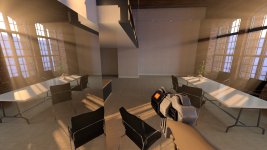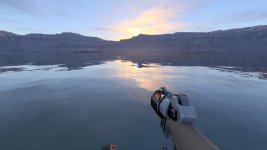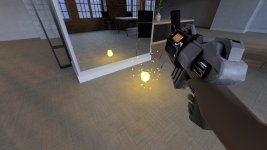Wrinkly, Quake 2 is 25 years old..... and Intel had cpu RT a decade ago for ir
-
Competitor rules
Please remember that any mention of competitors, hinting at competitors or offering to provide details of competitors will result in an account suspension. The full rules can be found under the 'Terms and Rules' link in the bottom right corner of your screen. Just don't mention competitors in any way, shape or form and you'll be OK.
You are using an out of date browser. It may not display this or other websites correctly.
You should upgrade or use an alternative browser.
You should upgrade or use an alternative browser.
Well done to Nvidia marketing
- Thread starter Harlequin
- Start date
More options
Thread starter's postsCaporegime
The opposite is unironically true for the unwashed masses
Right.
Even Tech Tubers 'behave' like they have this attitude and then call anyone who calls them out on it "AMD fanboys"
On the one hand complain about scalped pricing while at the same time tell their audience a 70% over MSRP scalped GPU is worth buying, of course it was an Nvidia GPU they went full hypocrite over.
Wrinkly, Quake 2 is 25 years old..... and Intel had cpu RT a decade ago for ir
Show me Quake 2 RTX running on 25 year old hardware

Show me Quake 2 RTX running on 25 year old hardware
Intel cpu quake Ray Tracing
That does look a little dated...
While Quake 2 RTX not so much.
Intel cpu quake Ray Tracing
While Quake 2 RTX not so much.
You can "facepalm" all you want, quake 2 is creeping up on 25 years old ffs.
Not bad for a ~25 year old FPS and yes, I'm a @Rroff fan -
As mentioned he stuck near 2 million tris in one test and there was virtual no slowdown - though there is more to it than that but at least as far as geometric complexity goes the renderer is untroubled by significantly higher levels of detail than the Quake 2 stock maps.
This one shows 1.2million in use:
In this case he is just using one material on most surfaces (though it does have all stages in use) to simulate load and doesn't have complex use of materials involving caustics, etc. but still.
People massively underestimate the capabilities of the renderer in Quake 2 RTX and/or still assume it is using optimisations like Minecraft to work due to the simple nature of Quake 2's maps when it isn't.
Game doesn't have bullet impacts as standard - I've not got around to adding bullet impacts that render correctly with RTX yet so it is a bit ugly but will suffice to demonstrate

One of the things that really stands out for me as well is the reflected scattered light

(Ignore the shell casings are floating and an old model with 8bit colour skins and not using RTX materials - I'm still very much prototyping)
The nice thing is you aren't limited to planes, etc. any object can have real time, accurate, reflections from all angles, etc. (though there is a limit currently on reflections of objects with refraction/reflections and/or multiple levels of transparency).
If you look at my test room screenshots (example below) it has large areas of glass on both sides, a large mirror and multiple glass, chrome and other reflective objects and is only 1.5% slower than the stock Quake 2 maps if that.
Typically the performance cost of rendering a scene in CP2077 with rasterisation maxed and RT maxed exceeds the impact it would have of rendering it via Quake 2's path tracer albeit the cost here comes at the constrained ray budget not being sufficient to remove noise from specular lighting to an ideal level.

EDIT: You can adjust the reflection/refraction bounces between 1 and 8, default 2, in Quake 2 RTX with only a moderate performance hit - obviously there is a point you don't get things rendered that would require more bounces to capture after a point hence the limited performance impact of increased scene complexity but there are few instances where that matters for a video game even though it would be nice to have higher.
It has its limits and there in some way to go yet to get ideal results with an ideal low level of visual noise from using denoising approaches to make up for limited ray budgets but the path tracer in Quake 2 RTX is much more than people give it credit for because they judge it from the stock Quake 2 maps.
Only Quake 2 RTX has a proper path tracing implementation of any sort which is fully used for all rendering (albeit even that isn't without some cheats*) - all the other games use a combination of some or all of using ray tracing only or partially in screen space, using simplified re-renders of the scene often missing a lot of details and often captured at a far lower resolution. In CP2077 for instance a small amount of ray tracing is used as a reference for scattered light and only from a limited number of sources (primarily the sun) and then the rest faked up using traditional techniques referenced against the smaller number of ray traced samples (I'm overly simplifying the system they use). A lot of the shadows are generic imposters projected into the scene rather than using proper ray tracing as well again with a limited amount of ray tracing used to guide the results. The sad thing is in many cases just getting a lite version of those features running still has a good slice of the performance overhead of a more complete solution for ray tracing the whole scene but is the minimum implementation required just to get some small level of the features in use.
Quake 2 RTX still has many compromises - especially the ray budget right now just doesn't allow for denoising results to an optimal level - but it is far far more capable than people who haven't spent time experimenting with it allow for and can significantly exceed the visual results of traditional techniques even though it can't hit the heights of offline ray tracers yet and is no way limited to the Quake 2 engine for results. We still need ideally 2-4x the ray budget to be able to satisfactorily remove noise from specular lighting, etc. despite the claims of some there is no reason why it can't be used to render a game like CP2077 with viable performance.
* For instance specular lighting is only fully path traced out to medium distance - the specular lighting on far objects uses a fast approximate cheat which is mostly indistinguishable to the real thing though not 100%. Caustics are only partially implemented (for time rather than performance as the stock maps don't really have features that would use it) and use fast approximate simulation which can look quite fake in certain scenarios (but again the developer never spent any time on it).
EDIT:
Turned off the sun light to show all the windows, etc. are doing reflections, etc.:
With lots of reflections and refraction, etc. as well as other features going on there isn't a huge performance difference to a standard map this holds true for even more complex scenes as well - for LOLs ran it at 4k on my 3070FE - 1440p is more where playable performance is at:
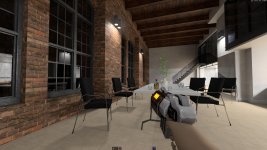
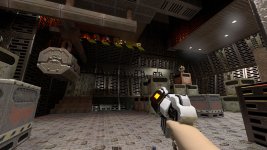
I've been playing quite extensively with the Quake 2 RTX implementation and working with a group that is expanding on its abilities (nail and crescent*) so I do have some idea.
* They've still got a long way to go but making some decent headway on expanding the Quake 2 RTX renderer https://www.youtube.com/watch?v=BIOJ6QURT5k
Soldato
Forgetting about RTX for a moment, GSync and DLSS both carry a premium and folks will pay it.
Dare I say it.. the AMD equivalents aren’t as good..
the AMD equivalents aren’t as good..
Dare I say it..
 the AMD equivalents aren’t as good..
the AMD equivalents aren’t as good..Permabanned
Best time to buy a Playstation 2 IMO.
Soldato
- Joined
- 22 Nov 2018
- Posts
- 2,715
AMD has been undercutting Nvidia for over a decade. Tell me something new.
Caporegime
Intel cpu quake Ray Tracing
CPU RT?
It says in the description
which is awesome and it looks good but i'll be shocked if the RT was done on a CPUby the Intel ray tracing research group

and Intel had cpu RT a decade ago for ir
The ET:QW ray tracing doesn't actually do lighting - it uses ray traced reflections and ray traced shadows generation* but doesn't actually light the world using ray tracing - no interaction with light bouncing off surfaces with colour transfer for indirect and scattered lighting, etc. etc. hence that video it all looks very flat. It was also running on like 4x server grade CPUs just to run at 720p 15FPS.
* Overly simplified but in this case it is just darkening areas using simple ray tracing to produce shadows while using traditional lights - whereas in path traced games or a proper ray tracer the world essentially starts black and is illuminated by bouncing rays of "light" leaving shadows where the light doesn't fall.
Last edited:
Caporegime
The ET:QW ray tracing doesn't actually do lighting - it uses ray traced reflections and ray traced shadows generation but doesn't actually light the world using ray tracing - no interaction with light bouncing off surfaces with colour transfer for indirect and scattered lighting, etc. etc. hence that video it all looks very flat. It was also running on like 4x server grade CPUs just to run at 720p 15FPS.
It could do with some Ray Traced Screen Space Global Illumination.
I've been with AMD since 2009, and I'm still eking out life from my i7-3770 with a 7950, but I was hoping to get a low-end new generation card to keep it going a bit longer. I've ordered a 3050, after months of hoping the 6600 would be cheaper, and then the 6500XT would not be absolutely ham-strung on PCIe-3.0.
I ordered the 3050 pretty much out of getting swept up in the launch excitement. But I've seen all the benchmarks and reviews that make it clear that the AMD 6600 or 6600XT is a much better deal. So I started to question if the 3050 was really the right card for me. And I realised it comes down to DLSS. So AMD has FSR, and quality quibbles aside, its an equivalent feature.
So back to the superior marketing: the reviews of recent GPUs that I have seen bring up DLSS performance but don't mention FSR. FSR is fairly recent, but AMD have released cards since then. Just looking at TechPowerUp, their review template for AMD doesn't include FSR, but the nVidia reviews all measure DLSS. I think sub-consciously I picked up that DLSS is more widely supported. I don't know if it's true. If I look for information about FSR it is out there, but it's not simply finding me.
TechPowerUp just did a comparison of DLSS vs FSR for a game I want to play, God of War, which supports both. I can't really see the difference between them. So should I really equate DLSS with better? Or is that clever marketing?
I ordered the 3050 pretty much out of getting swept up in the launch excitement. But I've seen all the benchmarks and reviews that make it clear that the AMD 6600 or 6600XT is a much better deal. So I started to question if the 3050 was really the right card for me. And I realised it comes down to DLSS. So AMD has FSR, and quality quibbles aside, its an equivalent feature.
So back to the superior marketing: the reviews of recent GPUs that I have seen bring up DLSS performance but don't mention FSR. FSR is fairly recent, but AMD have released cards since then. Just looking at TechPowerUp, their review template for AMD doesn't include FSR, but the nVidia reviews all measure DLSS. I think sub-consciously I picked up that DLSS is more widely supported. I don't know if it's true. If I look for information about FSR it is out there, but it's not simply finding me.
TechPowerUp just did a comparison of DLSS vs FSR for a game I want to play, God of War, which supports both. I can't really see the difference between them. So should I really equate DLSS with better? Or is that clever marketing?
Permabanned
You should look at more examples to make your own mind up, not just one game.I've been with AMD since 2009, and I'm still eking out life from my i7-3770 with a 7950, but I was hoping to get a low-end new generation card to keep it going a bit longer. I've ordered a 3050, after months of hoping the 6600 would be cheaper, and then the 6500XT would not be absolutely ham-strung on PCIe-3.0.
I ordered the 3050 pretty much out of getting swept up in the launch excitement. But I've seen all the benchmarks and reviews that make it clear that the AMD 6600 or 6600XT is a much better deal. So I started to question if the 3050 was really the right card for me. And I realised it comes down to DLSS. So AMD has FSR, and quality quibbles aside, its an equivalent feature.
So back to the superior marketing: the reviews of recent GPUs that I have seen bring up DLSS performance but don't mention FSR. FSR is fairly recent, but AMD have released cards since then. Just looking at TechPowerUp, their review template for AMD doesn't include FSR, but the nVidia reviews all measure DLSS. I think sub-consciously I picked up that DLSS is more widely supported. I don't know if it's true. If I look for information about FSR it is out there, but it's not simply finding me.
TechPowerUp just did a comparison of DLSS vs FSR for a game I want to play, God of War, which supports both. I can't really see the difference between them. So should I really equate DLSS with better? Or is that clever marketing?
If you need help on what equates to differences in quality, some people here can help you.
I don't think it is a good idea to make people less ignorant if it is not effecting theirs or others experiences.
Ignorance can end up in costing less in this case.. is good

Soldato
- Joined
- 16 Aug 2009
- Posts
- 7,750
I've been with AMD since 2009, and I'm still eking out life from my i7-3770 with a 7950, but I was hoping to get a low-end new generation card to keep it going a bit longer. I've ordered a 3050, after months of hoping the 6600 would be cheaper, and then the 6500XT would not be absolutely ham-strung on PCIe-3.0.
I ordered the 3050 pretty much out of getting swept up in the launch excitement. But I've seen all the benchmarks and reviews that make it clear that the AMD 6600 or 6600XT is a much better deal. So I started to question if the 3050 was really the right card for me. And I realised it comes down to DLSS. So AMD has FSR, and quality quibbles aside, its an equivalent feature.
So back to the superior marketing: the reviews of recent GPUs that I have seen bring up DLSS performance but don't mention FSR. FSR is fairly recent, but AMD have released cards since then. Just looking at TechPowerUp, their review template for AMD doesn't include FSR, but the nVidia reviews all measure DLSS. I think sub-consciously I picked up that DLSS is more widely supported. I don't know if it's true. If I look for information about FSR it is out there, but it's not simply finding me.
TechPowerUp just did a comparison of DLSS vs FSR for a game I want to play, God of War, which supports both. I can't really see the difference between them. So should I really equate DLSS with better? Or is that clever marketing?
dlss has been around for longer so it makes sense theres more reviews of it out there, as regards FSR compatibility theres an option in CP2k77 as well as dlss, not that there are many titles that support that either its largely for "big" titles that are effectively a tech demo/marketing tool. Speaking as someone who owns an RT card is it worth shelling out extra for it... honestly no.
Thanks for the encouragement! I think we all have different abilities to perceive more or less detail in things. When I watch a movie in 4K with HDR it is night and day to me - but the rest of my family appear unable to spot the difference from SD. In some DLSS vs FSR images I can see a clear difference, but I don't think it will be able to spot it in the heat of a game.You should look at more examples to make your own mind up, not just one game.
If you need help on what equates to differences in quality, some people here can help you.
I'm like this with another interest that is financially open-ended: headphones. I consider this a blessing; I can hear improvements only so far up the price-range, then it just all sounds good. Reviewers can describe all these details that I can't hear. OK I've heard some very expensive stuff that is amazing but way out of my budget.
as regards FSR compatibility theres an option in CP2k77 as well as dlss, not that there are many titles that support that either its largely for "big" titles that are effectively a tech demo/marketing tool. Speaking as someone who owns an RT card is it worth shelling out extra for it... honestly no.
I'm review-blind! I got the impression from reviews that all games pretty much implemented DLSS now, but of course, the reviewers are picking the "big" titles because they get YouTube views and ad-revenue.
And you've hit my hidden requirement
 I want to play CP2k77. And it supports both.
I want to play CP2k77. And it supports both.Thanks all! OP, your thread put a little salt on a wound I didn't quite realise was there. I jumped on the 3050 launch for reasons related to marketing. My card was delayed, and thanks to all the thought-provocation in this thread I decided to switch my order to an RX 6600XT. I'm staying Team Red for another round.
I'd like to recommend a great book for anyone interested in the levers used by sales and marketing. "Influence: The Psychology Of Persuasion by Robert B Cialdini. It's written like a guide on how to use 7 fundamentals to persuade people, but I can't help but read it more as a guide to defending myself.


